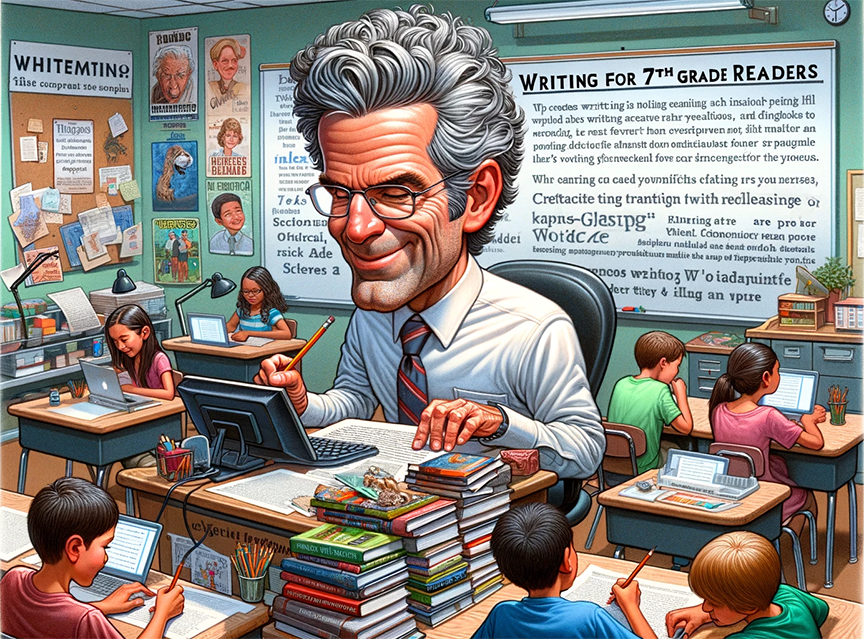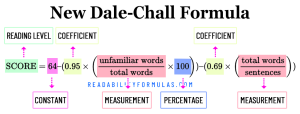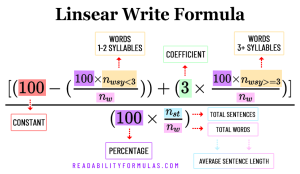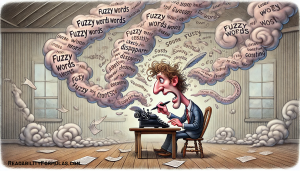 A 7th-grade reader is between 12-13 years old and is developing both academically and emotionally. Texts for 7th graders follow common syntactic patterns that align with their reading level.
A 7th-grade reader is between 12-13 years old and is developing both academically and emotionally. Texts for 7th graders follow common syntactic patterns that align with their reading level.
Sentence Length
- Average Sentence Length: 15-20 words
- Range: A mix of shorter sentences (5-10 words) and longer, more complex sentences (20-30 words)
Sentence Complexity
- Simple Sentences: About 30-40% of sentences
- Compound Sentences: About 25-35% of sentences
- Complex Sentences: About 20-30% of sentences
- Compound-Complex Sentences: About 5-15% of sentences
Paragraph Structure
- Average Paragraph Length: 4-6 sentences
7th Grade Reading Rate
Average reading rate is 150-200 words per minute, though this will vary based on the reader and text complexity.
Word Length
Word length, measured by the number of letters in a word, also adds to text complexity. For 7th graders, you can see a variety of word lengths. Here’s a general breakdown:
Short Words (1-4 Letters):
- These make up a large portion of the text, around 50-60%.
- Examples include “the,” “and,” “is,” “cat,” “jump.”
Medium-Length Words (5-7 Letters):
- These common words make up 30-40% of the text.
- Examples include “brother,” “running,” “quickly.”
Long Words (8+ Letters):
- Roughly 5-10% may be longer, more complex words.
- Examples include “community,” “entertainment,” “organization.”
Content-Specific Long Words:
- In texts about subjects like science, history, or literature, readers may encounter longer words specific to the content. These words may be explained or defined within the text.
Complexity of Themes and Topics:
- The length of words may vary based on themes or topics. More advanced texts may include a higher percentage of longer words.
Impact on Readability:
- Texts with a higher percentage of longer words may challenge the reader more. Be mindful of word length, sentence structure, and vocabulary to match texts to the right reading level.
Vocabulary:
- Educators may provide support for understanding and using longer words through instruction, context clues, and other strategies.
Correlation with Syllables:
- Longer words often have more syllables, adding to the phonetic complexity of the text.
Punctuation
- Commas, Periods, Question Marks: Regularly used
- Colons, Semicolons: Introduced but less frequent
- Parentheses, Dashes: Used sparingly for bonus information or emphasis
Vocabulary
- Tier 2 Vocabulary: High-utility, academic words that are sophisticated but not overly specialized
- Some Tier 3 Vocabulary: Subject-specific or specialized words with explanation or context
Grammar and Syntax
- Varied Sentence Starters: Different ways to begin sentences (adverbs, conjunctions, prepositional phrases)
- Subordination and Coordination: Use of subordinating and coordinating conjunctions to join clauses
- Active and Passive Voice: Primarily active voice but with some passive constructions
Dialogue and Quotations
- Proper Use of Quotation Marks: For dialogues and direct quotations
- Internal Dialogue Representation: May include characters’ thoughts or internal dialogues
Use of Figurative Language
- Similes and Metaphors: Commonly used for imagery
- Personification, Onomatopoeia, Alliteration: Introduced and used to create literary effects
Narrative Techniques
- Varied Point of View: First person, third person limited, or omniscient point of view
- Flashbacks or Foreshadowing: May be introduced for complex storytelling
Repeat Words vs. Unique Words
The ratio of unique words to repeat words is known as lexical diversity, and it is an important aspect of text complexity. This ratio can vary based on the type of text, subject matter, and author’s style.
Unique Words:
- Expect 20-30% of unique words in a text. This percentage might increase in texts that cover specialized topics or use a rich and varied vocabulary.
Repeat Words:
- The remaining 70-80% of words are repetitions previously used in the text. These repeat words include common function words (e.g., “the,” “and,” “is”) and content words essential to the text’s main themes or concepts.
Impact on Readability and Engagement:
- A higher percentage of unique words might make a text engaging and intellectually stimulating, but could also make it challenging to read. Conversely, a higher percentage of repeat words can reinforce understanding but might engage readers less.
Content-Specific Vocabulary:
- In subject-specific texts, such as science or history, you may find a higher percentage of unique words related to the subject. The author might repeat these words to reinforce understanding.
Literary Texts:
- Literary texts, such as novels and poems, may have more unique words to create imagery, mood, and character. The repetition of words or phrases may also be used deliberately for effect.
Abbreviated Words
The percentage of abbreviations can vary significantly. Here are some general guidelines:
Fiction Texts:
- Percentage: Approx. 1-3%.
- Usage: Abbreviations in fiction are limited to dialogue or specific contexts where they would naturally occur.
- Example: Common titles like “Mr.” or “Dr.,” or colloquial expressions.
Non-Fiction Texts:
- Percentage: Approx. 3-5%.
- Usage: In non-fiction, especially in subject areas like science or history, abbreviations and acronyms might be used more frequently.
- Example: “U.S.” for United States, “WWII” for World War II, “DNA” for deoxyribonucleic acid.
Textbooks or Educational Materials:
- Percentage: Varies, could be up to 5-10%.
- Usage: Textbooks might use abbreviations for repeated terms or when introducing specific concepts.
- Example: “e.g.” for example, “i.e.” for that is, or subject-specific abbreviations like “kg” for kilograms.
Syllables
Syllables also determine reading complexity and accessibility. Here’s a breakdown of what you might expect:
Average Syllables per Word:
- Around 1.4 to 1.6 syllables. This reflects a mix of monosyllabic and multisyllabic words suitable for this grade level.
Use of Monosyllabic Words:
- Around 60-70% of the words may be monosyllabic. These words form the core of English and are more familiar.
Use of Multisyllabic Words:
- Roughly 30-40% of the words may have two or more syllables.
Within this category, you may find:
- 2-syllable words: 15-20%
- 3-syllable words: 8-12%
- 4 or more syllable words: 3-5%
Challenging Vocabulary:
Challenging words with three or more syllables may be added to stretch readers’ vocabulary and reading comprehension. Words like: “unforgettable,” “disappointment,” or “entertainment.”
Content-specific Multisyllabic Words:
In subject-specific texts, such as science or history, students encounter multisyllabic terms like “photosynthesis” or “Constitution.” Definitions and explanations are often provided for these terms.
Poetic and Literary Texts:
In poetry or literary prose, syllables are varied to create rhythm, imagery, or emotional effect. These texts have more multisyllabic words and require more guidance and discussion to understand fully.
Reading Aloud and Phonics Support:
Reading aloud and phonics activities can assist 7th graders in tackling multisyllabic words by breaking them down into manageable parts.
The syllable structure helps strike a balance between readability and challenge. The blend of simpler and more complex words encourages readers to expand their vocabulary and comprehension while providing accessible and engaging reading material.
Active Voice vs. Passive Voice
The balance between active and passive voice can affect readability and engagement.
Active Voice:
- Percentage: Around 70-90%.
- Usage: Active voice is more direct and engaging. It’s preferred in storytelling and most non-fiction texts.
- Example: “The scientist conducted the experiment,” instead of “The experiment was conducted by the scientist.”
Passive Voice:
- Percentage: Around 20-30%.
- Usage: Passive voice can be used to emphasize the action rather than the doer of the action. It might be more common in scientific writing or formal reports, where the focus is on the result or process.
Subject-Specific Considerations:
- In science or formal academic writing, the passive voice might be used more frequently to create an objective tone.
- In literature or general non-fiction, active voice is used more to create an engaging and accessible style.
Teaching Considerations:
- In 7th grade, students begin to distinct between active and passive voice and how to use each. They might be encouraged to use active voice in their writing but also recognize situations where passive voice is appropriate.
Impact on Reading:
- Excessive use of passive voice can make a text more challenging to read, as it often needs more cognitive processing. However, some passive constructions are better for conveying specific meanings or adhering to a writing style.
Parts of Speech
- Nouns: 20-25%.
- Verbs: 15-20%.
- Adjectives: 10-15%.
- Adverbs: 5-10%.
- Conjunctions, Prepositions, Interjections: Varying percentages depending on writing style.
Proper Nouns
The percentage of proper nouns in a text for 7th graders also varies depending on the genre, subject matter, and context.
Fiction Texts:
- Percentage: 5-8%.
- Use: This includes the names of characters, locations, specific events, etc.
- Example: In a novel set in a real-world location, names of cities, landmarks, and people are common.
Non-Fiction Texts:
- Percentage: 3-6%.
- Use: historical names, brand names, scientific terminology, and so on.
- Example: A history text might include names of significant individuals, places, and events.
Textbooks or Educational Materials:
- Percentage: Varies, around 4-7%.
- Use: Specific terms, names of theories, scientists, historical figures, and geographical locations.
- Example: In a science textbook, names of scientists, theories, and specific terminologies are considered proper nouns.
Cultural and Contextual Considerations:
- The frequency of proper nouns might influence cultural references and the subject matter.
Reading Comprehension and Engagement:
- Too many unfamiliar proper nouns without context or explanation can hinder reading comprehension.
Numbers
Fiction Texts:
- Percentage: 1-3%.
- Length: Shorter numbers like dates, ages, or quantities.
- Use: Numbers in fiction might relate to time, age, quantity, or other basic numerical information.
Non-Fiction Texts:
- Percentage: 2-5%.
- Length: Varies depending on the topic. Short numbers for general information, longer numbers for scientific or mathematical content.
- Use: This could include dates, statistics, measurements, etc.
Textbooks or Educational Materials:
- Percentage: Varies widely, from 5-15% or more, especially in mathematics or science texts.
- Length: Can vary from simple, single-digit numbers to more complex numbers, including decimals, fractions, or large quantities.
- Use: Numbers in educational texts could represent anything from simple counting to complex mathematical or scientific data.
General Advice:
- Comprehension: The complexity and frequency of numbers should match the readers’ numerical literacy. Long and complex numbers may be challenging for some 7th graders, depending on their math background.
- Contextual Clues: Providing context or explanation for numbers, especially if they are central to understanding the content, is essential.
- Subject-Specific Texts: In subjects like mathematics, physics, or economics, complex numbers are used more.
- Culture: Numbers might be influenced by cultural norms, such as the use of commas or periods in large numbers.
Dialogue vs. Description (for Fiction)
- Dialogue: 40-60% (can vary widely based on author’s style and genre).
- Description/Narration: 40-60%.
Text Cohesion
- Transition Words: Approximately 3-5%.
Vocabulary Stats
Here’s a breakdown of vocabulary for 7th-grade readers.
- Vocabulary Size: Student know around 20,000 to 25,000 English words.
- Lexile Range: Texts align with a Lexile measure 950L to 1075L, a measure of text complexity.
- Academic Vocabulary: Students can understand and use 700-900 academic words across various subjects. Roughly, this consists of:
-
- Science: 150-200 words
- Mathematics: 100-150 words
- History: 150-200 words
- Literature: 100-150 words
- Reading Comprehension: 60-80% for age-appropriate material.
- Words per Minute (WPM): The average reading rate ranges from 150-200 WPM.
- Morphological Understanding: Understanding complex words through Latin and Greek roots might cover around 300-500 common roots and affixes.
What is a 7th Grade Reading Level?
A text scored at a 7th grade reading level has more complex language, themes, and structures.
- Sentence Structures: Sentences may include multiple clauses and higher-level punctuation. For example, “While she studied for her history test, her brother, who had already finished his homework, played his favorite video game.”
- Multifaceted Plotlines: Books may contain several intertwining plotlines or themes. An example is “Harry Potter and the Order of the Phoenix” by J.K. Rowling, where she introduces various storylines with friendship, politics, magical education, and personal growth.
- Abstract Ideas and Themes: Themes like moral ambiguity, identity, and self-discovery are explored. A novel like “The Giver” by Lois Lowry introduces concepts of utopia, memory, and societal control that provoke deeper thinking.
- Use of Figurative Language: 7th graders are exposed to metaphors, similes, allegories, and symbolism. For instance, in “A Wrinkle in Time” by Madeleine L’Engle, the concept of the “tesseract” is used as a symbol to connect dimensions of space and time.
- Vocabulary: Words outside of everyday language begin to appear in their reading. In “The Hobbit” by J.R.R. Tolkien, words like “flummoxed” and “beseech” are included, which may require the reader to use context clues or a dictionary.
- Non-Fiction and Varied Genres: They might read historical accounts, scientific explanations, or biographical texts that require comprehension of factual information and more formal language. For example, “Diary of a Young Girl” by Anne Frank provides historical insight into World War II from a teenager’s viewpoint.
- Author’s Craft: Readers in 7th grade start to identify literary devices such as irony, foreshadowing, or unreliable narrators. Edgar Allan Poe’s short stories, like “The Tell-Tale Heart,” exemplifies these techniques.
Teachers, parents and caregivers might use a mix of classical literature, contemporary novels, and non-fiction texts to create a well-rounded reading experience.
7th Grade Vocabulary Overview
Word Recognition:
- Complex Words: Readers can recognize and understand more complicated words that are subject-specific or related to themes in literature, such as “democracy,” “metabolism,” or “foreshadowing.”
- Multisyllabic Decoding: Readers can decode multisyllabic words by recognizing syllable patterns and using phonics skills.
Context Clues:
- Inferencing Meaning: 7th grade readers can infer the meaning of unknown words by examining the surrounding text, looking for synonyms, antonyms, explanations, or examples in the context.
Word Roots, Prefixes, and Suffixes:
- Morphological Awareness: Readers begin to understand common word roots and affixes (prefixes and suffixes), enabling them to deduce the meanings of unfamiliar words. For example, knowing that “tele” means distant can help with words like “telescope” or “telecommunication.”
Domain-Specific Vocabulary:
- Subject-Related Terms: Readers can comprehend vocabulary in subjects like science, history, or literature. For example, in science, words like “photosynthesis” or “ecosystem” become part of their vocabulary.
Synonyms and Antonyms:
- Expression: Readers can identify synonyms and antonyms, allowing for expression and understanding of nuances in meaning. They might recognize that “benevolent” is a synonym for “kind,” but with a slightly different connotation.
Figurative Language:
- Idioms and Metaphors: Readers begin to understand figurative expressions, such as idioms, metaphors, and similes. They can interpret phrases like “break a leg” or understand metaphorical comparisons like “the world is a stage.”
Writing and Speaking:
- Expressive Vocabulary: Readers can apply new vocabulary in their writing and speaking, enhancing their ability to communicate ideas more precisely and creatively.
Reference Materials:
- Dictionary and Thesaurus Skills: Readers are adept at using dictionaries, thesauruses, and online tools to look up unfamiliar words, understand multiple meanings, and find synonyms and antonyms.
Vocabulary in Different Contexts:
- Adapting Language: Readers can adjust their language based on the context, recognizing the difference between formal and informal language, and choosing words accordingly.
Cultural and Global Awareness:
- Exposure to diverse reading materials can help them understand words and expressions from various cultural backgrounds, fostering global awareness.
Overall, 7th-grade readers’ vocabulary skills reflect a move towards greater complexity, nuance, and adaptability. This development supports their ability to comprehend more sophisticated texts, engage in critical thinking, and express themselves with greater clarity and creativity.
7th Grade Word Usage
Word usage reflects a growing command of language that allows for more nuanced and expressive communication.
Complex Sentence Structure:
- Compound and Complex Sentences: Readers are beginning to use more compound and complex sentences, combining ideas using conjunctions like “although,” “however,” and “therefore.”
- Varied Sentence Openings: Readers can vary sentence beginnings to create interest and rhythm in their writing.
Descriptive Language:
- Adjectives and Adverbs: Readers can use adjectives and adverbs to provide more detailed descriptions, such as “The swiftly flowing river wound through the lush, green valley.”
- Sensory Details: Readers are developing the ability to use sensory details to create vivid imagery in their writing.
Figurative Language:
- Similes and Metaphors: Readers may use similes and metaphors to add depth to their writing, such as comparing ideas or feelings to something tangible. E.g., “Her smile was as bright as the sun.”
- Idiomatic Expressions: Readers can use idioms in their speech and writing because they understand their figurative meanings.
Formal vs. Informal Language:
- Understanding Register: Readers can recognize when to use formal language in academic or professional settings and informal language with friends or family. For example, using “cannot” instead of “can’t” in a formal essay.
Subject-Specific Vocabulary:
- Appropriate Usage: Readers are learning to use subject-specific vocabulary in subjects like science, history, or mathematics, understanding when and how to use these terms accurately.
Persuasive Language:
- Rhetorical Devices: Readers may begin to experiment with rhetorical devices like rhetorical questions, repetition, or parallel structure to persuade or engage their audience.
Transition Words and Phrases:
- Cohesiveness: Readers use transition words and phrases to guide the reader through their ideas and show connections between thoughts, such as “in addition,” “on the other hand,” or “as a result.”
Pronoun Consistency:
- Proper Use of Pronouns: Readers can understand pronoun-antecedent agreement, ensuring that pronouns match in number and gender with the nouns they refer to.
Connotation and Tone:
- Word Choice for Effect: Readers can choose words for their connotative meanings. They understand how word choice affects the tone and mood of a piece. For example, using “slim” instead of “skinny” to convey a more positive tone.
7th Grade Word Usage Challenges
Complex Multisyllabic Words:
- Examples: “Photosynthesis,” “apprehension,” “circumference.”
- Challenge: The length and complexity of these words can make pronunciation and understanding difficult.
Homonyms, Homophones, and Homographs:
Words that sound or look the same but mean differently can confuse them in both reading and writing.
- Examples: “lead” (to guide) vs. “lead” (a type of metal), “two” vs. “too” vs. “to.”
Technical and Subject-Specific Vocabulary:
These terms are often new and specific to subjects such as science, literature, or mathematics, requiring context and background knowledge.
- Examples: “mitosis,” “allegory,” “quadratic.”
Words with Uncommon or Irregular Spellings:
Unusual or non-phonetic spelling can make these words difficult to read, spell, and remember.
- Examples: “pneumonia,” “rhythm,” “colonel.”
Advanced Abstract Concepts:
Words that represent complex, abstract ideas may need higher-level thinking and context to fully grasp.
- Examples: “existential,” “philosophy,” “dichotomy.”
Idiomatic Expressions and Figurative Language:
These phrases often cannot be understood literally, and understanding them requires familiarity with cultural context.
- Examples: “Bite the bullet,” “the ball is in your court.”
Background Knowledge or Cultural Awareness:
Without prior knowledge or context, these words might be challenging to comprehend.
- Examples: Names of historical events, cultural terms like “samurai” or “Renaissance.”
Words with Multiple Meanings:
Choosing the correct meaning based on context requires careful reading and understanding.
- Examples: “light” (not heavy vs. illumination), “bark” (of a tree vs. a dog’s sound).
Formal and Archaic Language:
Readers will see these confusing words in classical literature.
- Examples: “thou,” “whence,” “heretofore.”
Language with Emotional or Social Nuance:
Words that convey subtle social or emotional nuances might require maturity and social awareness to fully understand.
- Examples: “sarcasm,” “empathy,” “prejudice.”
Foreign Words and Phrases:
Words and phrases borrowed from other languages may be unfamiliar and require explanation.
- Examples: “déjà vu,” “cliché,” “tsunami.”
Words that Break Standard Phonics Rules:
These words don’t follow typical sound-letter correspondence, making them tricky to read and spell.
- Examples: “through,” “though,” “knight.”
Conclusion
The best writing style for 7th graders strikes a balance between complexity and clarity. It challenges readers to grow their comprehension and analytical skills without overwhelming them. By using a mix of sentence types, appropriate vocabulary, and clear organization, writers can create engaging and educational texts for this age group.
Long, David. “Writing for 7th Grade Readers — Syntactic Stats.” ReadabilityFormulas.com, 21 Jan. 2025, https://readabilityformulas.com/syntactic-writing-for-7th-grade-readers/.










